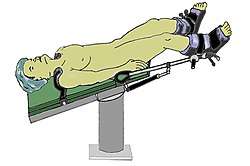Lloyd-Davies position
Lloyd-Davies position is a medical term referring to a common position for surgical procedures involving the pelvis and lower abdomen. The majority of colorectal and pelvic surgery is conducted with the patient in the Lloyd-Davies position. It was popularised for these procedures by Oswald Lloyd-Davies working at St Marks Hospital London.[1]

Lloyd-Davies Position
It is derived from the Trendelenburg position but with the legs abducted to allow access to the perineum. The basic angle is a 30-degree Trendelenburg with the hips flexed at 15 degrees; this can be adjusted with leg supports.
Advantages
- The position gives good exposure and may minimize pressure area damage in longer surgeries.
- It has fewer neuropathological side effects compared with other positions, notably lithotomy position where the hips are almost fully flexed.
Disadvantages
- Uncommonly it can precipitate compartment syndrome in muscles of calves after 5 or more hours of surgery.[2]
gollark: Sorry, what "power"?
gollark: I disagree with their formatting choices, and besides that, other languages have unofficial formatters you can use for shared stuff.
gollark: Compile on any system for any system: I think lots of stuff does that relatively well.
gollark: Anyway, some abstractions work, others don't. It's not black and white.
gollark: I don't work too seriously with Lua; my big projects are in other stuff. Type safety isn't horribly important, but if the language advertises it it should support it.
See also
References
This article is issued from Wikipedia. The text is licensed under Creative Commons - Attribution - Sharealike. Additional terms may apply for the media files.